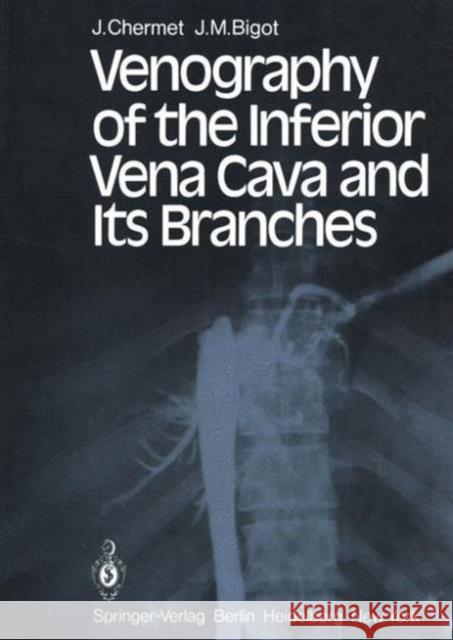Venography of the Inferior Vena Cava and Its Branches » książka



Venography of the Inferior Vena Cava and Its Branches
ISBN-13: 9783642675812 / Angielski / Miękka / 2011 / 232 str.
Venography of the Inferior Vena Cava and Its Branches
ISBN-13: 9783642675812 / Angielski / Miękka / 2011 / 232 str.
(netto: 384,26 VAT: 5%)
Najniższa cena z 30 dni: 385,52 zł
ok. 22 dni roboczych
Bez gwarancji dostawy przed świętami
Darmowa dostawa!
1. Techniques of Angiographic Investigation of the Inferior Vena Cava.- 1.1 Cavography by Percutaneous Bifemoral Approach.- 1.2 Cavography by Percutaneous Unifemoral Approach.- 1.3 Retrograde Iliac Venography.- 1.4 Cavography with Intracaval Catheter — Retrograde Femoral Approach.- 1.5 Cavography with Intracaval Catheter — Anterograde Approach.- 1.6 Occlusive Cavography.- 1.6.1 Uniocclusive Cavography.- 1.6.2 Biocclusive Cavography.- 1.7 Carboxyangiography.- 1.8 Contraindications for Bifemoral Cavography.- 1.9 Complications of Bifemoral Cavography.- References.- 2. Radioanatomy of the Inferior Vena Cava Pitfalls in Interpretation.- 2.1 Anatomy.- 2.1.1 Course.- 2.1.2 Anatomic Relations.- 2.1.3 Tributaries of the Inferior Vena Cava.- 2.2 Physiology.- 2.2.1 Cardiac Factors.- 2.2.2 Respiratory Factors.- 2.3 Radioanatomy — Pitfalls in Interpretation.- 2.3.1 Technical Factors.- 2.3.2 Anatomic Factors.- References.- 3. Congenital Anomalies of the Inferior Vena Cava.- 3.1 Review of the Embryology.- 3.1.1 Posterior Cardinal Veins.- 3.1.2 Subcardinal Veins.- 3.1.3 Supracardinal Veins.- 3.1.4 Conclusion.- 3.2 Congenital Anomalies of the Postrenal Segment.- 3.3 Congenital Anomalies of the Retrohepatic Segment.- 3.3.1 Absence of the Retrohepatic Segment (Azygos Continuation).- 3.3.2 Other Anomalies of the Retrohepatic Segment.- 3.4 Anomalies of the Left Renal Vein and Persistence of the Periaortic Venous Ring.- 3.5 Anomalies in the Termination of the Inferior Vena Cava; Terminations of Abnormal or Aberrant Vessels.- 3.6 Radiosurgical Applications.- 3.6.1 Surgery on the Postrenal Segment of the Aorta.- 3.6.2 Anomalies of the Left Renal Vein: Further Radiosurgical Applications.- References.- 4. Intrinsic Iliocaval Pathology. Thromboembolic Disease of the Iliac Veins and of the Inferior Vena Cava.- 4.1 General Remarks.- 4.2 Thrombophlebitis of the Iliac Veins.- 4.2.1 Definition.- 4.2.2 Clinical Symptoms.- 4.2.3 Preoperative Angiographic Investigations (Phlebography of the Lower Limb and Iliocavography).- 4.2.4 Radioanatomic Forms.- 4.2.5 Evolutive Forms.- 4.2.6 Etiologic Forms.- 4.3 Left Common Iliac Compression Syndrome.- 4.3.1 History — Definition.- 4.3.2 Radioanatomy of the Junction of the LCIV with the Inferior Vena Cava.- 4.3.3 Pathologic Anatomy.- 4.3.4 Etiology: Congenital or Acquired?.- 4.3.5 The Angiographic Features of the Syndrome.- 4.3.6 Common Iliac Compression Syndrome.- 4.4 Thrombosis of the Inferior Vena Cava.- 4.4.1 Frequency, Etiology, Radioanatomic Localization.- 4.4.2 Radioclinical Diagnosis.- 4.5 Membranous Occlusions and Stenoses of the Inferior Vena Cava Termination.- 4.5.1 Etiology.- 4.5.2 Pathologic Anatomy.- 4.5.3 Clinical Symptomatology.- 4.5.4 Evolution.- 4.6 Surgery in Iliofemoral and Iliocaval Phlebitis.- 4.7 Surgical Prevention of Embolic Migration.- References.- 5. Collateral Circulation.- 5.1 General Remarks.- 5.2 Unilateral Iliac Obstruction.- 5.2.1 Collateral System of the Iliofemoral Segment.- 5.2.2 Collateral System of the Common Iliac Segment.- 5.3 Bilateral Iliac Obstruction (Without Caval Obstruction)..- 5.4 Postrenal Occlusion of the Inferior Vena Cava.- 5.4.1 With Recanalization.- 5.4.2 Without Recanalization.- 5.5 Obstruction of the Middle Portion of the Inferior Vena Cava.- 5.6 Obstruction of the Upper Portion of the Inferior Vena Cava.- References.- 6. Retroperitoneal Compressions of the Inferior Vena Cava.- 6.1 The Retroperitoneal Space.- 6.1.1 Limits.- 6.1.2 Contents.- 6.2 Kidney.- 6.3 Adrenals.- 6.4 Arterial Anomalies.- 6.5 Retroperitoneal Tumors.- 6.5.1 Histologic Classification.- 6.5.2 Technique.- 6.5.3 Cavographic Radiosemiology in Retroperitoneal Tumors.- 6.5.4 Value of Cavography in the Diagnosis of Retroperitoneal Tumors.- 6.6 Retroperitoneal Lymph Node Involvements.- 6.6.1 Technique.- 6.6.2 Radiosemiology.- 6.6.3 Place of Cavography in Investigation of Retroperitoneal Lymph Node Involvements.- 6.6.4 Conclusion.- 6.7 Tumors of the Inferior Vena Cava.- References.- 7. Retroperitoneal Fibrosis.- 7.1 Clinical Data.- 7.2 Radiologic Investigations.- 7.2.1 Intravenous Urography.- 7.2.2 Inferior Vena Cavography.- 7.2.3 Other Radiologic Investigations.- 7.3 Treatment.- References.- 8. Inferior Vena Cavography in Hepatic and Intraperitoneal Diseases.- 8.1 Anatomical Considerations.- 8.1.1 Upper Segment (Hepatic Segment).- 8.1.2 Lower Segment.- 8.2 Technique.- 8.2.1 Hepatic Pathology.- 8.2.2 Nonhepatic Abdominal Pathology.- 8.3 Radiologic Features.- 8.3.1 Hepatic Diseases.- References.- 9. Renal Venography.- 9.1 Anatomy.- 9.1.1 Right Renal Vein.- 9.1.2 Left Renal Vein.- 9.1.3 Intrarenal Venous System.- 9.2 Technique.- 9.3 Normal Findings.- 9.3.1 Right Renal Vein.- 9.3.2 Left Renal Vein.- 9.3.3 Intrarenal Veins.- 9.4 Pathologic Findings.- 9.4.1 Pathology of the Vein Proper.- 9.4.2 Tumoral Pathology.- 9.4.3 Other Renal Parenchymal Diseases.- 9.5 Indications.- 9.5.1 Thromboses of the Renal Veins.- 9.5.2 Appreciation of the Extension of Renal and Retroperitoneal Tumors.- 9.5.3 Silent Kidneys.- 9.5.4 Intraparenchymal Infiltration Processes.- 9.5.5 Hematuria with Irregularities in the Renal Pelvis.- 9.5.6 Miscellaneous.- 9.6 Conclusion.- References.- 10. Adrenal Venography.- 10.1 Review of the Anatomy.- 10.2 Technique.- 10.2.1 Right Adrenal Vein Catheterization.- 10.2.2 Left Adrenal Vein Catheterization.- 10.2.3 Withdrawal of Blood Samples.- 10.2.4 Filming.- 10.2.5 Incidents and Accidents.- 10.3 Results.- 10.3.1 Normal Findings.- 10.3.2 Pathologic Findings.- 10.4 Indications.- 10.5 Conclusion.- References.- 11. Spermatic Venography.- 11.1 Embryology.- 11.2 Anatomy.- 11.2.1 The Spermatic Veins.- 11.2.2 Venous Drainage of the Scrotum.- 11.3 Technique.- 11.4 Results.- 11.5 Other Indications.- References.- 12. Hepatic Venography.- 12.1 History.- 12.2 Anatomy.- 12.2.1 Left Hepatic Vein.- 12.2.2 Sagittal or Middle Hepatic Vein.- 12.2.3 Right Hepatic Veins.- 12.2.4 Dorsal Veins.- 12.2.5 Anatomic Variations.- 12.2.6 Anastomoses.- 12.3 Technique.- 12.3.1 Afferent Approach.- 12.3.2 Direct (Transhepatic) Approach.- 12.3.3 Retrograde Approach.- 12.4 Pathologic Findings.- 12.4.1 Cirrhosis.- 12.4.2 Budd-Chiari Syndrome.- 12.4.3 Results.- 12.4.4 The Cardiac Liver.- 12.4.5 Intrahepatic Expansive Processes.- 12.4.6 Perihepatitis Chronica Hyperplastica.- References.- 13. Pelvic Venography in Females.- 13.1 Introduction.- 13.2 Angiographic Exploration Techniques.- 13.2.1 Bifemoral Percutaneous Iliocavography.- 13.2.2 Selective Utero-ovarian Phlebography (Uni- or Bilateral).- 13.2.3 Selective Hypogastric Venography.- 13.2.4 Hypogastric Venography by Pertrochanteral Approach.- 13.2.5 Injection into a Vulvar Varix or into the Dorsal Vein of the Clitoris.- 13.2.6 Phlebohysteroangiography.- 13.2.7 Pelvic Phlebography by Transpubic or Transischiatic Approach.- 13.2.8 Conclusion.- 13.3 Radioanatomy of the Pelvic Veins in Women.- 13.3.1 Hypogastric Venous System.- 13.3.2 Uterine Venous Plexus.- 13.3.3 Ovarian Veins.- 13.3.4 Veins of the Vulva.- 13.4 Pelvic Venography in Genital Tumors.- 13.5 Syndrome of Ureteral Compression by the Ovarian Vein.- 13.6 Pelvic Varices in Women.- 13.7 Pelvic Veins and Pulmonary Embolism.- References.- 14. Lumbar Phlebography.- 14.1 Technique.- 14.2 Radioanatomy.- 14.3 Indications.- 14.3.1 Disk Herniation.- 14.3.2 Lumbar Neuralgia.- 14.3.3 Lumbar Canal Stenosis.- 14.3.4 Tumor.- References.
1997-2025 DolnySlask.com Agencja Internetowa
KrainaKsiazek.PL - Księgarnia Internetowa









